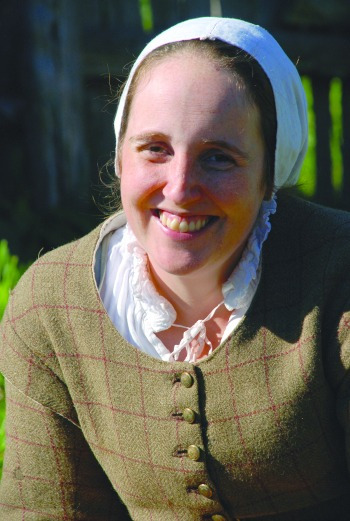For Thanksgiving, I’m talking to an actual pilgrim, straight from Plimouth Plantation in Plymouth, Mass. Every day, Malka Benjamin wakes up and transforms herself into Mary Warren, an actual person from the 17th century. When she’s not at the Plantation, she visits classrooms in the role of Goodwife Constance Snow. In honor of Thanksgivukkah, Goodwife Constance Snow will be the guest speaker at Havurah on the Hill’s Thanksgivukkah Shabbat on Friday, Nov. 15, at 6:30 p.m. at the Vilna Shul in Boston. Find more information here.
You play an actual, historical person at Plimouth Plantation. Who are you?

At the moment, I actually portray three different characters! Each character has her own unique back-story and personality. My main character this year has been Mary Warren, who in 1627 is 17 years old. Since Mary Warren did not travel aboard the Mayflower, I play a different character when I work at Mayflower II. There, I play a woman named Dorothy who is an indentured servant to the Carver family. (John Carver was the first governor of Plymouth Colony, elected March 23, 1620.) When I’m off-site presenting curriculum-based programming, I portray Goodwife Constance Snow, who traveled to the New World with her whole family aboard the Mayflower in 1620.
Constance’s father, Stephen Hopkins, is an interesting character in his own right—in 1609 he left the family in England to travel to Jamestown aboard the Sea Venture. After sailing through a hurricane, the ship wrecked on the island of Bermuda, where all the passengers were stranded for the better part of the year. Some historians believe that accounts of the wreck provided the inspiration for Shakespeare’s play “The Tempest.”
Do you have the same day over and over again, like in the film “Groundhog Day,” or is there a new adventure every day?
In the village, we follow the calendar year, so whatever date it is when you visit in 2013, it will be that day in 1627. Over the course of the year, we re-create many of these events, as well as follow the typical rhythms of a 17th-century agricultural community. So every time you visit, it’s a new and different adventure! We always portray 1627, so if you were to visit next year, it would still be 1627—we never get to 1628.
On Mayflower II, no matter when you visit, it’s always the same date: March 24, 1620. The original Mayflower was only in New England for a few months, so it wouldn’t be possible to portray an entire year. In that sense, yes, on the Mayflower II it’s exactly like “Groundhog Day”!
I would imagine Thanksgiving is the biggest day of the year for you guys! What do you serve? Things from your garden?
Yes, Thanksgiving is a big day for us! The museum as a whole presents special programming around Thanksgiving, including harvest dinners where you get to eat 17th-century food and be entertained by Pilgrims. These ever-popular dinners are available by advance reservation throughout October and November. On Thanksgiving Day itself, the museum also serves a turkey buffet dinner, which is quite popular.
However, in 1627, Nov. 28 was just a normal day, so you won’t find anything special going on in the 17th-century English village to mark the holiday. In fact, in the 17th century, a “day of thanksgiving” actually meant a day of fasting and prayer to thank God for a blessing that he had sent unto you.
The loose historical antecedent of our modern holiday of Thanksgiving is a sort of harvest feast that occurred in the autumn of 1621, after the struggling colonists brought in their first successful harvest. In fact, the only food we know they served for certain was venison!
But, as on any day you visit, you will find housewives cooking, busily preparing dinner—the midday meal—for their families. Part of my job as an historical interpreter is to maintain a large period-correct kitchen garden outside my house in the 17th-century English village. We use our garden produce in almost everything we cook, so you very well might see a Pilgrim housewife gathering something from her garden if you were to visit on Thanksgiving Day!
Of course this year Thanksgiving coincides with Hanukkah. Are you going to sneak a menorah in for Thanksgivukkah this year? Do you know anything about when Jews first got to the colonies?
Haha! Maybe—I haven’t decided yet! But I do plan on making Hanukkah cookies to bring as my contribution to our staff potluck Thanksgiving lunch that day!
I can tell you there were no Jews in Plymouth Colony in 1627. However, the first Jew known to be in the colonies predates the Pilgrims. In 1585, Joachim Gaunse, a metallurgist and mining engineer, was one of the settlers of Roanoke Island. In 1649, Solomon Franco, an agent for a Dutch Jewish merchant, showed up in Boston, but was forced to leave rather quickly.
The first Jews to permanently settle in North America do so in—where else?!—New York City, in 1654. These Jews were refugees from the settlement of Recife, in Brazil, which had recently been retaken from the Dutch by the Portuguese. Just four years later another shipload of Jews settled in Newport, Rhode Island. Historians speculate that these Jews were also refugees from Brazil, but likely spent a few intermediate years somewhere like Barbados.
Find everything you need to celebrate Thanksgivukkah at ThanksgivukkahBoston.com.


